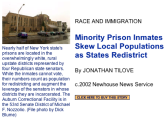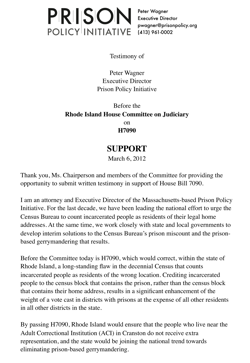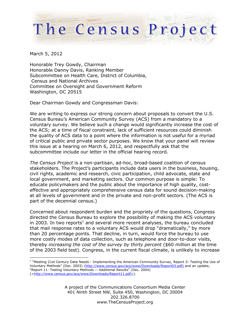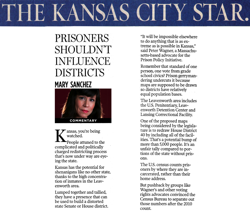Thanks to the 2010 law that ended prison-based gerrymandering in NY, Livingston County's democracy will no longer be distorted by prison populations.
by Leah Sakala,
March 26, 2012
One of the most dramatic cases of prison-based gerrymandering is about to be fixed.
Here’s what was wrong:
When Livingston County, New York drew new county legislative districts after the 2000 Census, all of the people incarcerated in the town of Groveland were used to make up a whopping 64% of the town’s political clout in county government. This was bad news for everyone who didn’t live in Groveland because it meant that every 4 people who live in the town with the prison had as much say in county government as 10 people who live elsewhere in Livingston County.
The Chair of the Livingston County legislature, who represents the town padded with the prison populations, told the New York Times that he doesn’t really represent the incarcerated people to whom he owes the bulk of his say in county affairs, explaining, “We don’t campaign; they don’t vote.”
Fast forward to today:
Thanks to the 2010 law that ended prison-based gerrymandering in New York, all Livingston County residents will enjoy equal access to the county legislature. This is because, as the Erie County Attorney General has affirmed, the law ending prison-based gerrymandering applies to both New York state legislative districts and and local government districts.
A recent Livingston County News article reports that now that the plaintiffs who sued to bring back prison-based gerrymandering have given up the case, the county will proceed with re-weighting the county voting system to reflect the people who actually call Livingston County home.
President and Director-Counsel of NAACP LDF passes; Under his leadership, LDF took up prison-based gerrymandering reform.
by Peter Wagner,
March 23, 2012
John Payton, the President and Director-Counsel of the NAACP Legal Defense and Educational Fund, Inc., passed away last night. The LDF writes:

John Payton, 1946-2012
John Payton, the President and Director-Counsel of the NAACP Legal Defense and Educational Fund, Inc., and a tireless advocate for justice, equality, and opportunity, died late Thursday after a brief illness. He was 65. LDF is deeply saddened and mourns this tragic loss.
John was the 6th leader of LDF, the nation’s first and preeminent civil rights law firm. During his tenure he guided the organization to resounding legal victories, including Lewis v. City of Chicago, which vindicated the rights of over 6,000 applicants who sought to become firefighters in the City of Chicago, and Northwest Austin Municipal Utility District v. Holder, which turned back a challenge to the constitutionality of a core provision of the Voting Rights Act of 1965. To the LDF staff and to a great many others, John was fearless – a guiding light, a brilliant advocate, a mentor and teacher who believed that American democracy thrives when it embraces all of our voices.
John Payton was a civil rights giant. His contributions to the movement are being chronicled better by others, and I’d like to focus on his work ending prison-based gerrymandering.
Under his leadership, the LDF took up the fight against prison-based gerrymandering. They published the indispensable Captive Constituents: Prison-Based Gerrymandering and the Distortion of Our Democracy, helped pass legislation in New York that ended prison-based gerrymandering, and joined in the successful defense of New York’s and Maryland’s laws ending prison-based gerrymandering.
John took a personal interest in the problem of prison-based gerrymandering, working with other African-American leaders to raise the issue with the Commerce Department in December 2009. As John explained:
Because incarcerated persons in the United States are disproportionately African Americans and other people of color, the current counting of prisoners at their place of incarceration, rather than at their pre-arrest residence, severely weakens the voting strength of entire communities of color.
He will be missed.
New Yorkers enjoyed a clear victory today, as plaintiffs in the Little v. LATFOR case dropped their challenge of the 2010 state law ending prison-based gerrymandering.
March 16, 2012
For Immediate Release: March 16, 2012
Please Contact:
| Brennan Center for Justice |
Madeline Friedman |
(646) 292-8357 |
madeline.friedman@nyu.edu |
| Center for Law & Social Justice |
April Silver |
(718) 756-8501 |
pr@akilaworksongs.com |
| Dēmos |
Anna Pycior |
(212) 389-1408 |
apycior@demos.org |
| LatinoJustice |
John Garcia |
(212) 739-7581 |
jgarcia@latinojustice.org |
| NAACP Legal Defense Fund |
Mel Gagarin |
(212) 965-2783 |
mgagarin@naacpldf.org |
| NYCLU |
Michael Cummings |
(212) 607-3300 x368 |
mcummings@nyclu.org |
| Prison Policy Initiative |
Peter Wagner |
(413) 527-0845 |
|
New York, NY – New Yorkers enjoyed a clear victory today, as plaintiffs in the Little v. LATFOR case dropped their challenge of the state law ending prison-based gerrymandering.
The law, known as Part XX, was passed in 2010 to increase fairness in redistricting by counting incarcerated people as residents of their home districts. The previous practice, often called prison-based gerrymandering, gave extra political influence to districts containing prisons, diluting the votes of every resident of a district with no (or fewer) prisons. The law corrects this bias and assures that all communities in New York have equal representation in our government.
A group of plaintiffs led by State Senator Elizabeth Little filed suit seeking to strike down the new legislation. She claimed that legislative districts — including her own, which contains 12,000 incarcerated persons — should be required to include prisoners when redistricting. After the lawsuit was filed, a Quinnipiac University poll showed that a majority of New Yorkers of all regions and parties supported the new law.
In December, New York Supreme Court Justice Eugene Devine ruled that the law was constitutional. The plaintiffs then sought to go directly to the Court of Appeals, bypassing the Supreme Court’s Appellate Division. The Court of Appeals declined to hear plaintiffs’ direct appeal on February 14. Plaintiffs then filed documents with the Appellate Division withdrawing the appeal.
The Brennan Center for Justice, the Center for Law & Social Justice, Dēmos, LatinoJustice PRLDEF, the NAACP Legal Defense and Education Fund, the New York Civil Liberties Union, and the Prison Policy Initiative represented 15 voters from around New York State who intervened in the lawsuit to defend the law. Attorneys for the organizations issued the following joint statement:
“Prison-based gerrymandering in New York unjustly diluted the voice of voters and gave undue political influence to districts with large prisons. By dropping this challenge, opponents acknowledged they were fighting a losing battle. As the redistricting process continues, we are pleased that incarcerated persons will be allocated where they belong — the communities from which they came and to which they overwhelmingly return. This victory helps ensure that all New Yorkers have an equal voice in our democracy.”
About Part XX and Prison-Based Gerrymandering
Part XX was a major civil rights victory that brought New York’s redistricting practices in line with the New York Constitution’s declaration that a prison is not a residence.
Enhancing the weight of a vote cast in a district with a prison dilutes the weight of a vote cast in all other districts without prisons. According to research by the Prison Policy Initiative conducted after the 2000 Census, prison-based gerrymandering has a particularly negative impact on the voting strength of African-American and Latino communities, because 81 percent of the state’s prison population is African-American or Latino, but 98 percent of the state’s prison cells are in disproportionately white Senate districts.
The most dramatic examples of prison-based gerrymandering are in upstate counties and cities. For example, half of a council ward in the city of Rome, New York is incarcerated. As a result, the actual residents of that ward wield twice the influence of other city residents. Recognizing the distortions caused by prison-based gerrymandering at the local level, 13 New York counties with large prisons — including four in plaintiff Senator Little’s district — have historically exercised their discretion to remove the prison populations prior to redistricting.
The law brings consistency to redistricting in New York, prohibiting both the state and local governments from giving extra political influence to districts that contain prisons.
The legal documents can be found at the Prison Policy Initiative web page for Little v. LATFOR.
A new article by John C. Drake, published in the Washington University Journal of Law & Policy explains the similarities between prison-based gerrymandering and the infamous 3/5 clause.
March 14, 2012

FOR IMMEDIATE RELEASE:
March 14, 2012
CONTACT:
John C. Drake, jcharlesdrake@gmail.com, (508) 340-0881
When states include prison populations in their legislative district maps, prison-host communities gain political power in the same way Southern states used slaves to gain extra representation in Congress, says a new article by John C. Drake, published in the Washington University Journal of Law & Policy. The article, “Locked Up and Counted Out: Bringing an End to Prison-based Gerrymandering” addresses a long-standing flaw in the U.S. Census that has been receiving considerable attention only in the last decade.
The U.S. Census counts people in prison as residents of the prison location, even though they remain residents of their pre-incarceration homes. Prisoners, who in 48 states may not vote, are disproportionately people of color; but prisons are typically located in disproportionately white, rural areas. When states use this data to draw districts, the result gives extra political influence to the districts that contain prisons, diluting the votes of everyone else. The New York Times editorial page coined the phrase “prison-based gerrymandering” to describe the practice.
“Comparing prison-based gerrymandering to the infamous three-fifths clause is a common rhetorical device,” says Peter Wagner, Executive Director of the Prison Policy Initiative and the nation’s leading expert on prison-based gerrymandering. “But John Drake goes further, and puts prison-based gerrymandering in the historical context.”
Prior to the elimination of slavery following the Civil War, the U.S. Constitution counted slaves as three-fifths of a person. “This is commonly misunderstood as an insult to Black Americans. But the real injustice was counting the slaves at all and swelling the political clout of the slave-owning South,” said Drake, a former journalist and a third–year law student at Washington University School of Law in St. Louis, Missouri. “Prison-based gerrymandering uses mass incarceration as a device for creating a new injustice: the dilution of voting strength in the urban communities that most prisoners call home.”
“Four states have so far had the wisdom to pass legislation to fix the Census Bureau’s prison miscount and end prison-based gerrymandering,” says Peter Wagner. “John Drake’s article is a powerful argument for why more states should follow their lead.”
“It was only through long, if ill-advised, negotiation that the framers of the U.S. Constitution included the three-fifths clause, which gave extra representation to the slave states,” said author John Drake. “Prison-based gerrymandering, by contrast, is an accidental by-product of modern rates of high incarceration. The result is no less pernicious – political power gained at the expense of a captive, disenfranchised population. States must now choose between intentionally diluting the votes of their own citizens who lack the good fortune of living near a prison, and using the legislative process to negotiate a solution.“
Drake’s article also notes:
- The Census rules on which prison-based gerrymandering relies are internally inconsistent: for example, students in boarding school are counted as residents of the parental home, whereas children in juvenile detention centers are counted as residents of the detention centers.
- Prison-based gerrymandering creates and strengthens rural state legislative districts, whose lawmakers’ interests often are at odds with the disproportionately black and urban prisoners on whose backs they’ve gained political power. The prisoners do not consider themselves constituents of those lawmakers, and the lawmakers typically do not treat them as such.
- Rural county legislatures have adopted a patchwork of policies to avoid dramatic cases of vote dilution like that in Florida’s Calhoun County where almost half of one district is incarcerated, giving the residents of that county district twice the political influence of other Calhoun County residents.
- Prison-based gerrymandering results in the dilution of minority voting strength, which invokes the protections of the Voting Rights Act.
The Washington University Journal of Law & Policy is committed to generating a symposium-based publication that brings together communities of scholars, through a mutual and collaborative student and faculty process, emphasizing existing and emerging visions of the law in relation to interdisciplinary and multicultural perspectives, the implications of technology, and the consequences of economic globalization for the purpose of influencing law and social policy.
The article is available on Lexis and Westlaw at 37 WASH. U. J.L. & POL’Y 237 (2012) and on the internet at http://openscholarship.wustl.edu/law_journal_law_policy/vol37/iss1/11
-30-
PPI made its public debut ten years ago, and the movement to end prison-based gerrymandering has come a long way since!
by Peter Wagner,
March 14, 2012
The Prison Policy Initiative had its first public debut ten years ago today, when I showed up at a redistricting hearing in the Bronx and told the committee to scrap their proposed maps and start over with a new dataset that counted incarcerated people at their true, home addresses. Prison populations shouldn’t be used to dilute the votes of people who do not live next to prisons. The public was intrigued by my testimony, but at that point the legislature didn’t take my advice.
Fast forward a decade: four states have ended prison-based gerrymandering. New York and Maryland have passed laws to count people in prison at home for this round of redistricting, and both states’ laws were successfully defended in court. Delaware and California passed legislation that will take effect after the next Census in 2020. The Census Bureau continued to count incarcerated people in the wrong place, but in 2010 they made an important change. They published the prison count data earlier than ever before, so that redistricting bodies would have the technical ability to avoid or minimize prison-based gerrymandering if they wished.
In that intervening decade, we worked to put numbers on the problem, develop solutions, and recruit civil rights, criminal justice and good government groups into a large movement for reform at the local, state and federal levels. Together, we’ve permanently changed how our democracy works in 4 states and hundreds of counties; and we’ve set our sights on a permanent national solutions.
Thank you for joining with us!
by Leah Sakala,
March 12, 2012
A proposed constitutional amendment in New York State would bring back prison-based gerrymandering, says redistricting expert Todd Brietbart and Common Cause of New York. City and State has the story: Democratic Expert: Redistricting Amendment Brings Back Prison-Based Gerrymandering [UPDATED]
Anna Pycior of Dēmos also weighed in: New York Redistricting Should Be Non-Partisan, Not Bi-Partisan
Anna’s piece ends:
This amendment is a scapegoat that offers little to no real reform. Being that it was only released last night, it’s too early to say what the likelihood is that it will be the “reform” promised by many legislators.
First national article to explain prison-based gerrymandering is still timely.
by Peter Wagner,
March 12, 2012

The first major national article about prison-based gerrymandering appeared ten years ago today. Jonathan Tilove, then the race and immigration reporter for Newhouse News Service, wrote a major feature that connected the dots between my academic research on how the Census Bureau’s prison counts distort democracy in the New York State legislature, Taren Stinebrickner-Kauffman’s research on prison demographics in Florida, and the redistricting struggles of county officials in Colorado, Louisiana and Florida.
To quote from Jonathan’s article, at the time the “issue [hadn’t] gained much serious attention or debate at the national or state levels.” But the article changed all that.
As I wrote on the 10th anniversary of the founding of the Prison Policy Initiative:
Prior to Jonathan’s article, explaining my research used to take hours. His piece helped us succinctly explain who benefits from prison-based gerrymandering. For example, in a single clear sentence Jonathan powerfully summarized one concept that used to take me 15 minutes to explain. Many of the innovations in Jonathan’s article informed how we constructed our “Importing Constituents” report, and Jonathan’s discussion of intra-rural impacts inspired our strategy for the next decade.
The article’s publication introduced our work to Brenda Wright, then managing attorney at the National Voting Rights Institute, and now Director of the Democracy Program at Demos. Brenda reached out to share her expertise and has been one of our closest advisors and colleagues ever since.
The movement to abolish prison-based gerrymandering has come along way since Jonathan’s article was written, with advances such as:
- The publication of dozens of reports on how prison-based gerrymandering distorts democracy in state and local governments across the country
- The New York Times editorial board coining the term “prison-based gerrymandering”
- Four states passing legislation to end prison-based gerrymandering
- The Census Bureau changing how prison count data is published
- Hundreds of counties and municipalities refusing to engage in prison-based gerrymandering
There’s been great progress since 2002, but the article is still a concise introduction to the problem, and a powerful explanation of how the Census Bureau’s prison miscount is bad for both urban and rural people. In Iberville Parish Louisiana, prison-based gerrymandering would have meant drawing a school board district that had only two voters. In the New York Senate, legislators who supported prison expansion boasted that they were glad that people incarcerated in their districts couldn’t vote because “they wouldn’t vote for me”.
Ten years ago, prison-based gerrymandering was virtually unknown. The issue was intriguing but complicated and obscure. Jonathan Tilove’s article was the first to focus on this problem and to give the public the tools they need to understand why prison-based gerrymandering needed to be abolished.
If you missed his article ten years ago, or if you haven’t read it again recently, today is a great time to read it again.
Several civil rights organizations submitted testimony to the House Committee on Judiciary in support of House Bill 7090, which would end prison-based gerrymandering in the state.
by Leah Sakala,
March 7, 2012

Yesterday several civil rights groups testified before the Rhode Island House Committee on Judiciary in support of House Bill 7090, which would end prison-based gerrymandering in the state.
The legislation would fix the harm caused by the Census Bureau’s prison miscount by requiring that incarcerated people be reallocated to their home addresses in state legislative redistricting data beginning in 2020. The bill would also bring Rhode Island’s redistricting practices in compliance with state law, which explicitly states that a prison is not a residence. By passing HB 7090, Rhode Island would join the growing national trend towards rejecting prison-based gerrymandering.
Organizations that testified in support of HB 7090 included the ACLU of Rhode Island, Common Cause Rhode Island, the Prison Policy Initiative, the Urban League, and Direct Action for Rights and Equality. The written testimonies submitted by the Prison Policy Initiative (testimony) and Common Cause Rhode Island (testimony) are available online.
As advocates pointed out, prison-based gerrymandering is especially problematic in Rhode Island because the state has a single prison complex that’s concentrated in one geographic location. This makes it particularly difficult to diminish the harm of prison-based gerrymandering by splitting the prisons into multiple pieces when drawing legislative redistricting maps.
In the current redistricting cycle, for example, the redistricting commission struggled with how to mitigate the harm of prison-based gerrymandering, and the final maps include a district that is 15% incarcerated. This means that 85 people in that district have as much political clout as 100 people who live in a district without a prison.
There was no opposition to the bill at last night’s hearing. It’s time for Rhode Island to take a stand and pass HB 7090 to ensure that prison-based gerrymandering does not compromise Rhode Island residents’ right to vote after the 2020 Census.
PPI signed on to a Census Project coalition letter in opposition to a recent proposal to make participation in the ACS voluntary rather than mandatory.
by Leah Sakala,
March 6, 2012

The Prison Policy Initiative joined more than 25 other Census Project organizations to send a letter to House congressional leaders in opposition to a recent proposal to make participation in the American Community Survey voluntary rather than mandatory.
The American Community Survey provides vital information to public and private sector decision-makers alike, and the coalition letter warns that making participation in the survey voluntary would dramatically compromise the data by decreasing the response rate and increasing the expense.
The Prison Policy Initiative typically focuses on how the Census Bureau’s method of counting people in prison in the decennial Census negatively affects the redistricting process. The expertise we developed for that project has led to a deeper appreciation for the importance of other Census Bureau data products. We’ve learned just how important the American Community Survey is, so we joined the Census Project in this important letter.
The letter concludes:
[W]e urge your subcommittee to view any proposal to make the American Community Survey voluntary with great caution. Such a change would have serious adverse consequences that could leave the nation in a precarious decision-making vacuum and hinder its economic recovery and future growth.
A new Kansas City Star piece by Mary Sanchez warns that prison-based gerrymandering may dramatically inflate the votes cast in a Kansas state legislative district.
by Leah Sakala,
March 5, 2012

Mary Sanchez has just released a great piece in the Kansas City Star about how prison populations are a big deal in Kansas state legislative redistricting.
She explains that the high concentration of correctional facilities in a single legislative district may cause the most dramatic instance of artificial vote inflation in any state district in the nation:
Kansas has the potential for shenanigans like no other state, thanks to the high concentration of inmates in the Leavenworth area.
Lumped together and tallied, they have a presence that can be used to build a distorted state Senate or House district. Prisoner counts can dilute voting power in some areas while falsely ramping it up for voters living near prisons.
She points out that not only does Kansas have the ability to refuse to engage in prison-based gerrymandering, its current practice of reallocating military and school populations for redistricting purposes has served as a national model for redistricting population adjustments:
Remember that standard of one person, one vote from grade school civics? Prison gerrymandering undercuts it because maps are supposed to be drawn so districts have relatively equal population bases.
The Leavenworth area includes the U.S. Penitentiary, Leavenworth Detention Center and Lansing Correctional Facility.
One of the proposed maps being considered by the legislature is to redraw House District 40 by including all of the facilities. That’s a potential bump of more than 5,000 people. It’s an unfair tally compared to portions of the state without prisons.
The U.S. census counts prisoners by where they are incarcerated, rather than their home address. But pushback by groups like Wagner’s and other voting rights advocates convinced the Census Bureau to separate out those numbers after the 2010 count.
Meaning if Kansas wanted to play this game fairly, it could.
In fact, Kansas is considered a model for addressing the temporary residency of college students and military personnel.
The Kansas legislature needs take swift action to remove prison populations from the population data used for redistricting purposes. Otherwise the state will dilute the votes of every resident who doesn’t live next to a prison, and become a dramatic national symbol of how prison-based gerrymandering dilutes your right to vote.









